Hooray ! Another newsletter has arrived, but let me tell you, dear readers, this has been quite a monumental task to complete, there have been many other calls on my time and I have not been at my best for a combination of reasons. However, despite all these interruptions, and the shauries, I ploughed doggedly on and made it through - though there were many times when I truly feared it would not.
To brighter things - this week I saw my first Christmas lights and also my first Christmas tree. Both were very cheery and very welcomed. There is no reason why you have to wait until Christmas Eve, you know. And if they are placed in positions where they can also cheer up any random passers-by sore in need of a little pleasure, all the better...
I have stalled a bit on the updates of the cards which are contained in the Card of the Day Index. It will resume over the weekend, after I have inserted the remaining reference book gleanings for these cards, as I am not sure I will get much of that done before the light is gone.
Anyway, without further ado, settle back into your comfiest chair, and allow our cast of characters to stumble unto view.......
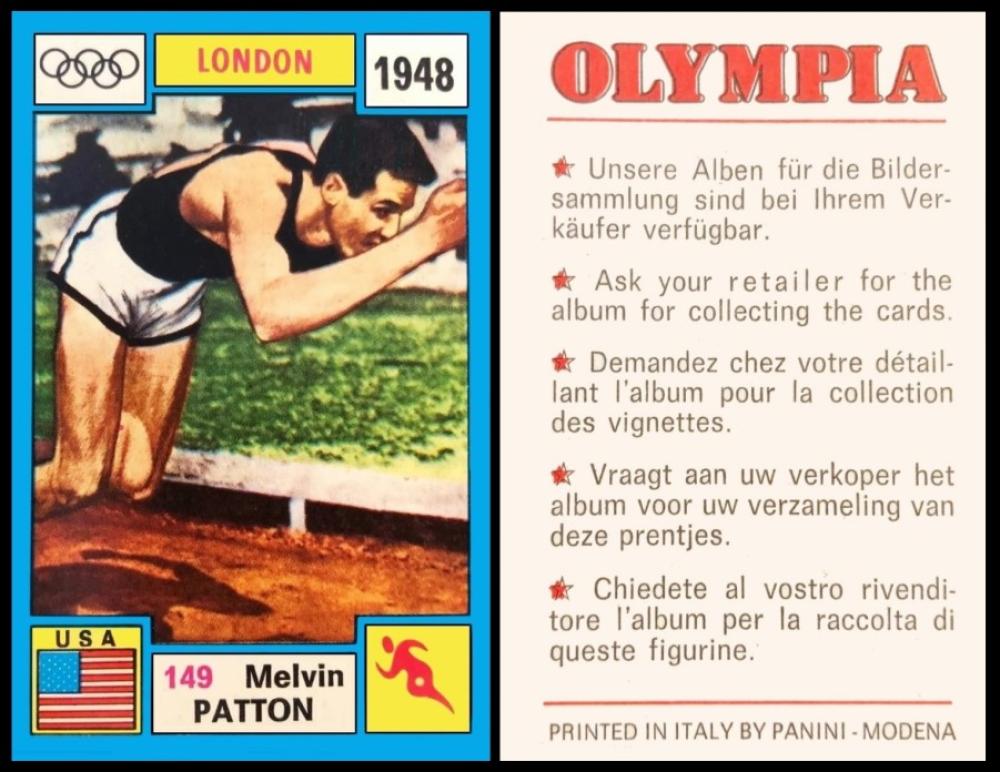
Panini [trade/commercial: cards : O/S - Italy] "Olympia" (1971) 149/287
Centenaries have been a bit thin on the ground lately, but here we have one, the birth of Melvin Emery Patton, on November the 16th, 2024.
He was born in Los Angeles, California, and he was just seven when the Summer Olympics came to town. I imagine that like many other children of that time, he must have been inspired by the various sports and headlines. Perhaps he remembered them when he went to University, or maybe it was just chance that he signed up for the track and field team, and only vaguely remembered them after.
He was always a hesitant runner, almost certainly because he had fractured his hip as a child - and he was therefore nursing both the actual injury and the worry over what he would do if he suffered the same fate again. He also served in the U.S. Navy during the Second World War, which occupied several years of what would have been prime competing time, and meant that he really only had three good competing seasons. However, by a stroke of luck, at just this time the 1948 Olympics came along, and he was also currently number one in the World Rankings.
The 1948 Olympics were held in a Great Britain which had not yet recovered from the War. Many of the competitors who might have been there were also missing - and not a single one of the six finalists from the 1936 Games were able to attend. War damage and logistics meant that though it was called the London Olympics not all of the events were in the Capital City - in fact they took place at twenty-five different venues, with the sailing taking place off Torbay in Devon, and the football heats being as far away as Brighton and Portsmouth, though some also took place at White Hart Lane, the home of Tottenham Hotspur. However, the track and field events were based just outside London and were staged in the Empire Stadium at Wembley.
The American team won more medals in the athletics than any other team, twelve gold, five silver and ten bronze. Runners up were Sweden, with five gold, three silver, and five bronze. The success of the Americans had been predicted, but with a twist, as the 1946 and 1947 champion Barney Ewell was expected to sweep the board and he did not - only winning one gold in the 4 x 100 metres relay and two silvers, for the 100 and 200 metres.
Mel Patton was not a household name, and his first race, the 100 metres, had seen him come home in fifth. His next event, the 200 metres, was not his length at all, he had never won a single event at that length, much preferring the shorter, faster, sprint races. However, on this day, he came home first. And he also shared a team gold for the 4 x 100 metres relay.
After this he spent some time in Australia, but returned to teach in America, and then became involved with the aerospace industry. He had dallied with joining the Air Force instead of the Navy in the Second World War, so perhaps that was a way of settling old regrets. Then he went to Saudi Arabia. e National Sports Programme of Saudi Arabia in the 1970s. However he did return to America, where he died in May 2014.
Now you may be asking why this set is dated 1971 when there was no Olympics in that year - the last one had been in Mexico City in 1968, and the next one would not be until 1972 in Munich. Sadly we remember that 1972 Olympics not for sporting prowess but for an act of terror, and perhaps this is why these cards are so seldom seen, even though there are some very sought after people in it, including Cassius Clay at number 208.
You can see a full checklist at the Trading Card Database/PO71 - where it is immediately striking just how few of the cards have been sent in to be shown against the names.
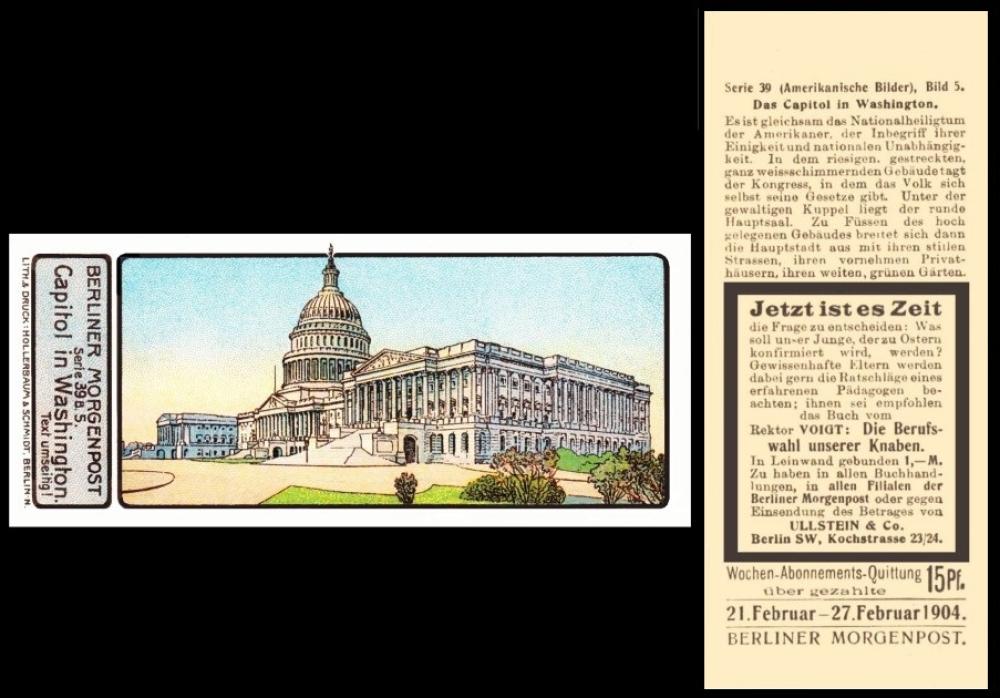
Berliner Morgenpost [trade : newspapers : O/S - Berlin, Germany] "Amerikanische Bilder" (1904) Serie 39, Bild 5
This day was one I struggled with for it started out as another centenary, of the release of the film "A Sainted Devil" with Rudolph Valentino - however I was unable to find any cards that showed that film and even hunting for co-star Nita Naldi proved fruitless.
So instead we are off to Washington, for a curious tale of the first time that the Capitol held the first ever session of the U.S. Congress. This happened in 1800, and the building was not actually finished yet and they had to use the North Wing. In fact it would not be entirely finished for another twenty-six years. However it was successful enough that it was decided that this would be the permanent site of all future meetings, replacing Philadelphia, where they had been based since 1790.
It seems that the earliest card to feature the Capitol was not until 1889, as part of Allen & Ginter`s unnumbered set of "General Government and State Capitol Buildings of the United States" (N14) - and the second not until 1911, in American Tobacco Company`s "Sights & Scenes of the World" (T99). The first card is backlisted, only telling the titles of the cards in the set so that the smoker could be sure to collect them all. However the second does have a descriptive back, where we are told that : "..the great dome of the Capitol [is] 288 feet high, [and is the] central feature of a structure which stretches along the brow of a hill for 751 ft. The main structure is of sandstone painted white, while the two wings, occupied by the Senate and the House of Representatives, are built of marble. In general, the style is classic, with Corinthian details. Beneath the dome is the Rotunda, 96 ft. in diameter and 180 ft, high, adorned with historical paintings."
I am not really sure when our card was issued, but I saw an earlier set listed as 1903. However it is not an American card, it comes from Germany, and is very different in style from the monochrome Berliner Morgenpost card of Alan Ladd that we featured in our newsletter of the 31st of August, 2024 as the diary card for Tuesday, 3rd September. Our set is much more striking and artistic, and there are, I now realise, lots of these sort of cards. They are not very easy to find out about though, so I do not know how many were in the set, I have only come up with these, repeatedly, so perhaps it was a set of six cards?
- Freheits Statue in New Yorker Hafen [Statue of Liberty in New York Harbour]
- Das Weiss-Haus, Washington [The White House, Washington]
- Brooklyn Brucke [Brooklyn Bridge]
- Tempel & Tabernakel in Salt Lake City [Temple and Tabernacle in Salt Lake City]
- Capitol im Washington [The Capitol in Washington]
And if anyone either knows the missing card six, or can supply any later numbers, do tell us please.
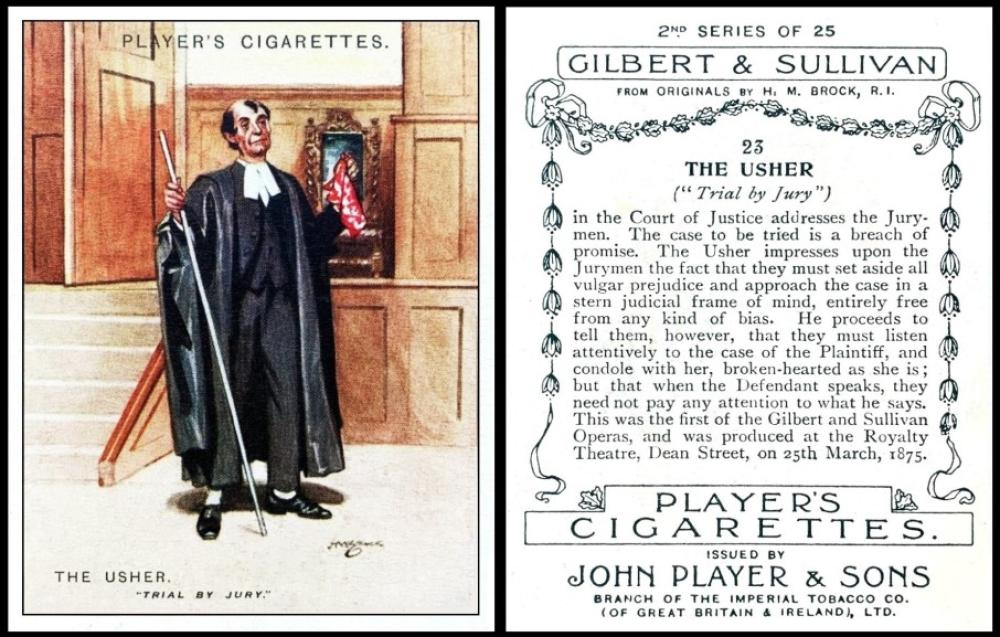
John Player & Sons [tobacco : UK - Nottingham] "Gilbert & Sullivan" - 2nd Series, large size (1927) 23/25 - P644-216.2.B : P72-104.2.B : P/108.B [RB.17/108.B]
Today, not so bad. I wrote on my paper for this date "W S Gilbert b 1836" and that is what we ended up with. The only problem was that I somehow put the wrong picture in here, but that has been altered now!
There is something very curious about William Schwenk Gilbert though, cartophilically, because everywhere I looked told me that the card we show here was his "rookie card" - and yet his partner, Arthur Seymour Sullivan had appeared twice before, in Ogden`s General Interest Series B, issued in 1901, and in W.D. & H.O. Wills` "Musical Celebrities", issued in 1912.
So if anyone can track down any earlier appearances of William Schwenk Gilbert, please tell.
Today, we still remember him, as a dramatist, but also as a poet, artist, and writer of the words for seventy five plays and fourteen comic operas, the last of which were written in association with Mr. Sullivan, the composer of the music. Our man was also a third of the triumvirate which ran the D`Oyly Carte Opera Company, named after the third man, Richard D`Oyly Carte.
It may have been very different if he had been allowed to go to war. For his childhood was rather chaotic, and he travelled widely. He did write, even then, but missed the excitement of travel once ensconced in schools and at King`s College, London, so he applied, on the strength of recent newspaper reports from the Crimean War, to the Royal Artillery. However, by the time he had done this, the war was over and they were, shall we say, no longer hiring. He did more research and discovered that he could travel the world with the Civil Service, so he got a job there, only to find that he was stationed as an assistant clerk in London, which he hated. He supplemented his income, and amused himself, by picking up his writing again. And he also got married, to Lucy Agnes Turner, eleven years his junior.
Then in 1863 he was left some money, and immediately resigned. He thought he might become a barrister, but that did not suit him either. By this time he was making quite a name for himself, albeit pseudonymously, and so he decided to become a writer, both fiction, and non fiction, and somehow in 1870 he found himself being asked if he would like to go to France as a war correspondent.
This cannot have lasted too long because in 1871 he was back in England, writing, and he was asked if he would like to write a play for Christmas. The only catch was that there was a partner. This was Arthur Sullivan. They worked well together but did not meet again for four years. After which they wrote frequently, and became good friends, until Arthur Sullivan died in 1900.
William Schwenk Gilbert was knighted in July 1907, for his great contributions to drama (Arthur Sullivan having been knighted some time earlier, in 1883). He lived a quiet life, having retired to a large house in Harrow Weald, until one fateful day in May 1911, when he offered to teach two young lady visitors to swim. One of these started to struggle in the water, and he leaped in, heedlessly, only to be struck down with a fatal heart attack before he could again reach the edge.
This set is none of the men involved in this story, but it is characters from their operettas and we have chosen this one because, as the card tells us, "this was the first of the Gilbert and Sullivan Operas, and was produced at the Royalty Theatre, Dean Street, on 25th March, 1875.
Our set appears in our original reference book to the issues of John Player, RB.17, issued in 1950, where it is catalogued as :
GILBERT & SULLIVAN. From originals by H.M. Brock, R.I. Fronts in colour. Backs in grey, with descriptive text. Home issues.
107. 1st Series
A. 50 small cards. Issued December, 1925
B. 25 extra large cards. Issued April, 1926108. 2nd Series
A. 50 small cards. Issued December, 1927
B. 25 extra large cards. Issued January, 1928
This is very much shortened for our World Tobacco Issues Index, where the listing reads just
GILBERT & SULLIVAN. Nd.
1 "A Series of .... " (A). Small (50) (B). Extra large (25)
2. "2nd Series of ..." (A) Small (50) (B) Large (25)
It is the same listing in our updated volume, but the sizes are abbreviated to "Sm" "Ex.Lg" and "Lg"
Now the odd thing is that despite the large cards being issued later, they have a very different and more artistic reverse, which makes them appear to be much earlier.
As for our card of the Usher, showing here, he also appears in the smaller sized cards. as card 46. And on that card the quote about this opera being their first does not appear.
Another difference between the two cards (and one which I will show, some time) is the size, for the larger card extends out to the side, showing a further section of the stairs to the left, and another section of panelling to the right. This means, too, that the character name has been moved over by some way. But you will see all this, some time!
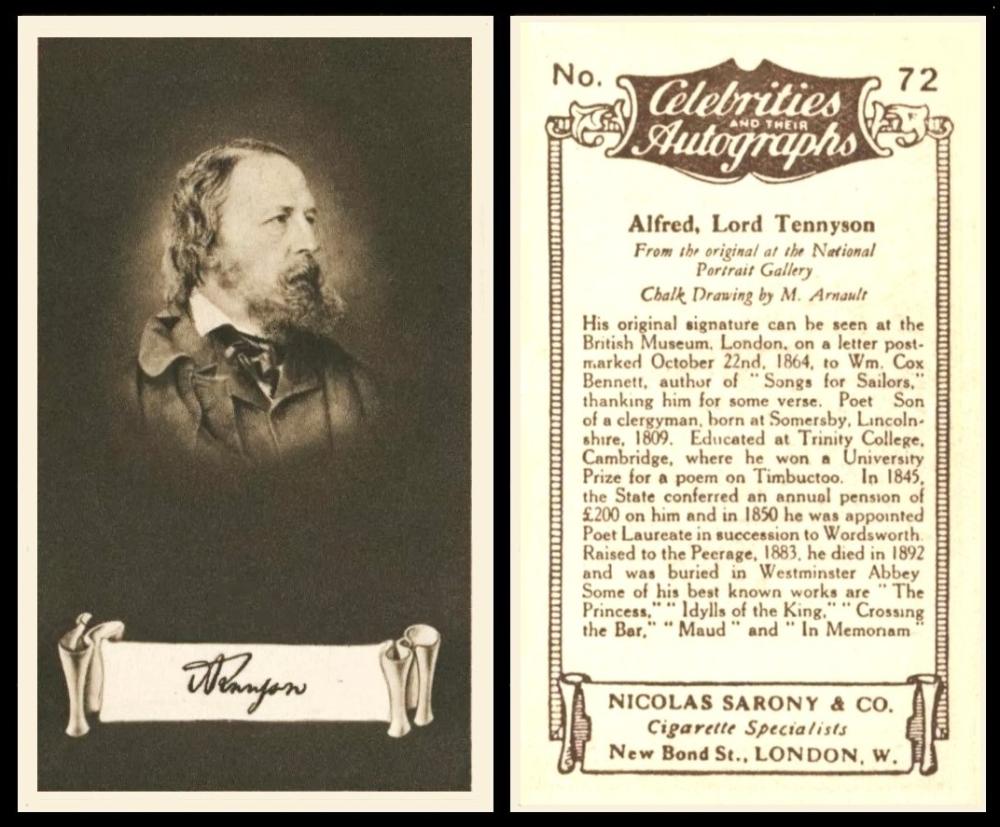
Nicolas Sarony & Co [tobacco - UK - London] "Celebrities and Their Autographs" - fourth series small size (1923) card 72 -
More literature now, for today in 1850 Alfred, 1st Baron Tennyson became Poet Laureate, succeeding William Wordsworth, who had been in office only from 1843; he died, unexpectedly, of pleurisy.
Alfred Tennyson had been born on the 6th of August 1809, and he was to remain Poet Laureate for most of Queen Victoria`s reign, though it had been her husband, Albert, who had put his name forward for the post. It is thought that Queen Victoria only grudgingly allowed it, having much preferred the suggestion of Elizabeth Barratt Browning - though she softened after Tennyson wrote a memoriam piece for her husband. However the two never met until a year after this, in 1862, and then not again until 1883.
Strangely, his writing had not been seen as very serious at all until he entered a poetry contest at Trinity College, Cambridge. Even then, the poem was not a new one, it was something he had been tinkering with for a while, trying, without success, to make it fit together. It was actually nothing to do with the stated subject for the piece either, of "Timbuctoo" - though many think that this contributed to its success, for everyone else who entered stuck to descriptions and his was rather more mystical and dreamlike, with Timbuctoo almost an afterthought.
He was most surprised to win. But when he did, it set him fast towards writing as a career, and he wrote almost every day until he died on 6 October 1892 at Aldworth, aged 83.
Our original World Tobacco Issues Index tells us that this is a set of many permutations, the listing of just our section being :
4. Nos. 76-100 (25)
Size (A) small (B) large
You can see the large size of this set as our Card of the Day for the 3rd of April, 2023 - and the entire listing of all the cards will be found as the Card of the Day for 26th June 2023, which is when we featured the first part of the set, numbers one to twenty five cards.
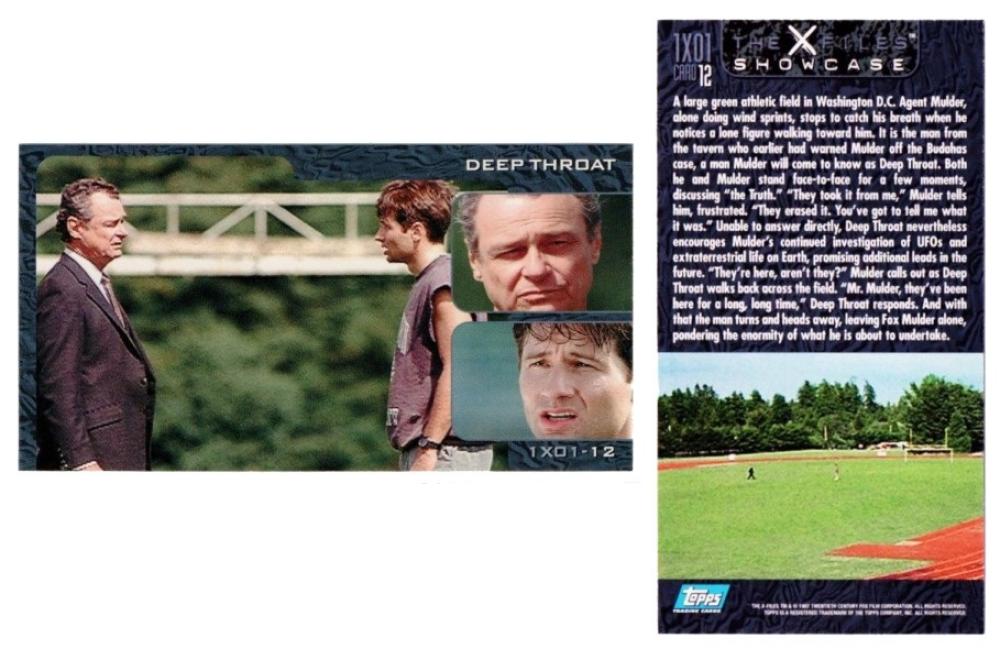
Topps [trade/commercial : cards : O/S - USA] "The X Files Showcase" (January 1997) card 1x01-12
This was the day that caused the most trouble, I had almost written something when I stumbled on the fact that I had not only used the same subject but the same card. Never mind the two have been combined there now. Then I spent an age looking for cards of Edwin Hubble, only finding one from a set which I had used before - and well remembering what a job it had been to find that card for the Channel Tunnel...
So you get this...
This marks the birth of Jerry Hardin, today in 1929, who is shown here as the character called "Deep Throat" from the X-Files, but who also appeared in many other very popular television shows, starting in the 1950s, as well as in both Star Trek The Next Generation and Star Trek Voyager.
His role in the X Files was actually sold to him as a one off appearance, in the second episode of the first series. However he continued to appear, even after his character was killed off in the finale of that first series - and in later series he would appear in flashbacks and visions, as well as in a very complex scene in the third series finale where several characters from the past morph into each other.
His character may be fictional, but there is a knowing reference to the true "Deep Throat" who leaked information during the Watergate scandal. Here too, our "Deep Throat" is an informer, slowly feeding information to the hungry Fox Mulder, so desperate to find the truth about aliens and their invasion of the planet. The subplot is that we are never really sure if "Deep Throat" is acting out of generosity or if the feeds are really false trails to throw our hero off the scent. Even at the end, when he is shot, we do not know if it is to stop him leaking the true truth, or to leave Fox Mulder even more vulnerable, and alone, and even more willing to accept other untruths being fed him by those who come to fill his empty void.
There is another cunning connection that may escape all but the most diehard conspiracy theorists, because the replacement ally that does turn up is called "X", and that was the code name of Donald Sutherland`s character in the film "JFK", which aimed to uncover the truth behind the killing of President Kennedy.
This is a very unusual set, being much longer than the standard cards, and it also contains more than one picture, being a main one flanked by two small vignettes. There were seventy two cards in the base set, but advertising for this mentions "three hundred images", which was rather contentious as it included all the vignettes front and back.
It is also unusual because it does not contain images from all the episodes, only six of them. There was a rumour that the other episodes might form a series two but this never turned up. What we did get were two promotional cards, one from the pilot episode (and you can tell that because instead of a number after the dash on the card code there is "P1") and one which is black and white and advertises the fan club with an American address. Then there were also two special insert sets, each of six cards, one being "Laser Cards" (where on each card there is a large letter "X" with strips cut out of it by laser), and the other being "X-Effect Cards", which look odd, being a frame with stills and a large blank space, until the card is held to light, when an image is revealed.
You can see checklists of all these at the Trading Card Database/XFilesShowcase.
And I am a few Laser cards short if anyone has any duplicates....
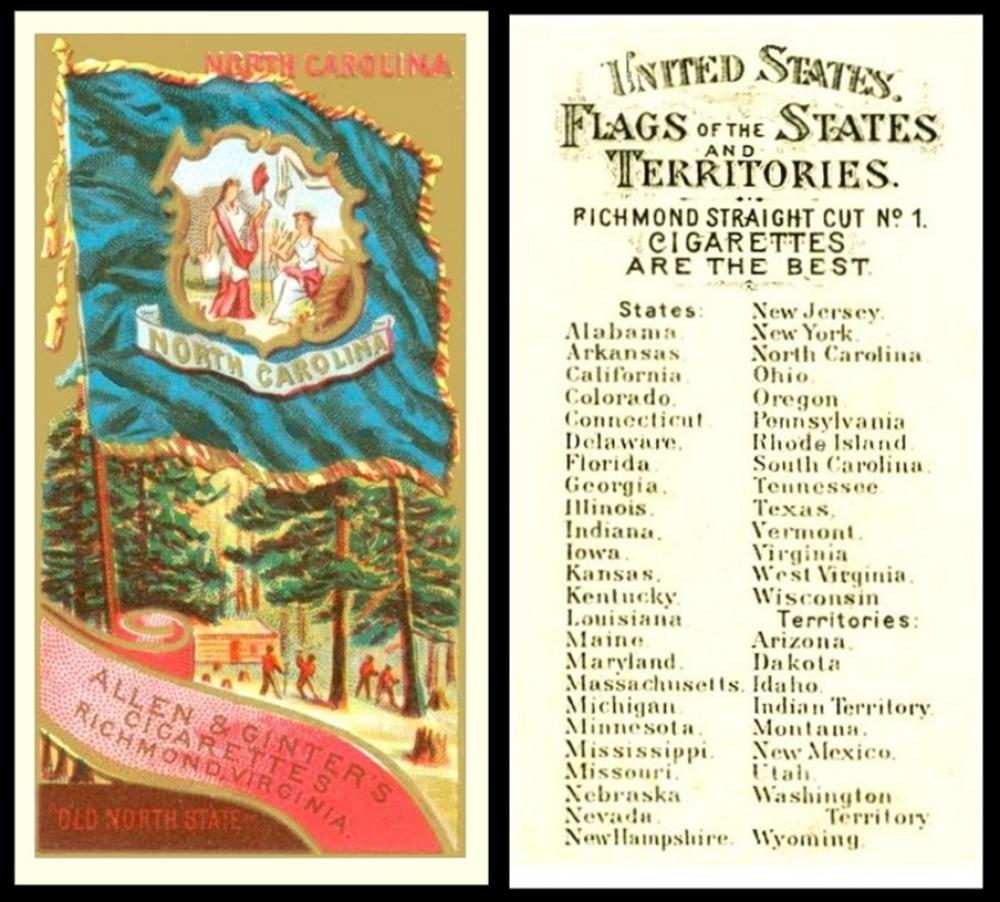
Allen & Ginter (tobacco : O/S - America) "United States Flags of the States and Territories" (1888) Bk/50
And so to North Carolina. At which point nipper ran off with my cheat sheet and tore it to tiny pieces, so I had to look up why I had written this, as well as find out what on earth I was doing for Friday. So these two will be shorter until tomorrow when I look at the books again. And this back came out well yellow, so I will have another go at that too.
The why was that today in 1789 North Carolina became the twelfth state in the Union, some two hundred years after the land was first settled by people from our shores. Between these two dates there had been many changes, not least the fact that at the time of settlement this area was called the Carolina Territory and encompassed the area of what is now South Carolina and Tennessee. In fact Carolina was named in honour of King Charles I - for Carolus is his Latin name.
North Carolina broke off in 1712, setting up its own rules and becoming a colony all its own. It then became a Royal English Colony in 1729. However South Carolina had also set up on its own in 1712, but became a Royal English Colony much earlier, in 1719. It was also the eighth state to join the Union.
Now for a cartophilist North Carolina is known as a huge centre of tobacco production - even before Sir Walter Raleigh took some back to his home shores. Perhaps natural then that Washington Duke would base his business there in the 1880s, and make tobacco production the highest employer and also the most profitable industry in the state.

J. A Pattreiouex [tobacco : UK - Manchester] "Cricketers Series" (1926)
To close, let us look at this man, John Thomas Tyldesley. He was born today in 1873, in Worsley, Lancashire, and he played cricket for that county all his life. His preferred stance was as a batsman, though he could bowl and also field, he just chose not to.
His first Lancashire match took place in 1895, and our card tells us not just that it was against Warwickshire, but that he was 152 not out.
He played more or less continuously until the outbreak of the First World War. And as to his cartophilic career, this begins with Ogden's "Tabs" General Interest Series A, in 1901, where it gives his birthplace of Worsley, and also tells us his "1st class batting average 1900, 37-92; total runs, 1,593. Made 200 v Derbyshire, at Old Trafford, 1898".
What is most noticeable is that most of these cards come from before the First World War, the last one being in 1912. It appears that he signed up, but I cannot trace a regiment, only that it was in the Army, and he rose in the ranks to become a corporal. If he did sign up it is probable that he was in the British Expeditionary Force, which went to France first in 1914, and there were only three Lancashire Regiments - 1st Battalion East Lancashire Regiment – the 2nd Battalion South Lancashire Regiment – and the 1st Battalion Loyal North Lancashire Regiment. More research will be done.
He was released from his army service in 1919. And though he did play for a while
he was never the same, so much so that he decided to retire at the end of the 1919 season and set up a sports goods shop in Manchester.
Now our card was issued much later than this, in 1926, and it curiously says "late Lancashire" on the front. This seems to suggest that it was actually produced after he had gone to war, or after his retirement in 1920, and did not get issued immediately. For in the whole of the 1920s he only played one match with the top team, in 1923, when he became the first professional Captain of the Lancashire team.
The sad truth is that he never did regain his health, or vigour, or the joy for life that he had felt before he off went to war.
And he died just a couple of years later in 1930, aged just 57.
Now before I close I must tell you that this set was reprinted in 1997 by Card Promotions, but full kudos to them, as there is no simple trimming off of the bottom to remove the reprint wording here. Instead they have made it almost impossible not to spot the fact that it is a reprint, for in the section where our card says "Smoke Trawler Critic, Club Member Cigarettes" their have printed "Reproduction by Card Promotions (c) 1997. First issued in 1928".
This week's Cards of the Day...
Saturday, 9th November 2024

We started our week with a different kind of football, American college football. And this card was a real teaser, but the clue was in the orange box on the reverse, the head of a beaver. This is a team logo - because Mr. Hodgins plays for the Oregon State Beavers football team, otherwise known as Oregon State University in NCAA Division 1 FBS college football.
This card shows Isaiah Hodgins, who, at the time of issue, was playing for Oregon State University - but since then he has moved to the National Football League, or NFL, being drafted by the Buffalo Bills just after this card was issued, and subsequently moving to the New York Giants.
It astounds me just how popular these players can become - for in what is a relatively short span of time, the Trading Card Database/Isaiah Hodgins has him on over five hundred cards.
As for the Oregon State Beavers, they are on almost eight thousand cards - but curiously their first is stated to be the 1960 set of Topps` "Tattoos". I am not so sure about this, as the team began way way back in 1893. Perhaps this is because at that time it was the Oregon Agricultural College, and the link has never been explored ?
This is the basic base set, with white margins, but this is a very baffling set, with lots of specials - fear not, though, for there is a list of all the component parts, and a checklist, at Beckett.com/2020Score.
Sunday, 10th November 2024
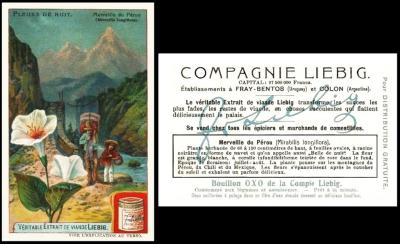
This clue gave us the night, for though you can see the moon on clear days in the early evening and just after dawn, it is at its best, and brightest, in the darkness of the night.
As for the flower, that is the Marvel of Peru, or Mirabilis Jalapa, or the Four o'Clock Flower, because the flowers tend to open at dusk (usually between 4 and 8 o'clock). And though here it is shown in the white form, for some reason, it does come in a range of colours, yellow, pink and white being the most common
This is an unusual subject, and its dark colours make it really stand out amongst the other sets. You may think that night flowers, or nocturnal flowers, are also rare, but they are surprisingly common, their scents designed to appeal to such insects as moths and flies, but also to bats, and beetles. After all, night technically begins at dusk, when many creatures are on their way home, or just beginning to stir for a new night`s adventure.
The flowers included are also more familiar than you might imagine, they are :
- Cereus Grandifloreus (night blooming cactus)
- Jacinthe Tubereuse (tuberous hyacinth)
- Julienne (night scented gilliflower)
- Merveille du Perou (Belle de Nuit)
- Oenothere des Pres (evening primrose)
- Victoria Regie (Amazonian water lily)
This set was issued in several versions. The ones you are most likely to come across are in Belgian or French (both as the same title, of "Fleurs de Nuit"), German, ("Nachtblutler"), or Italian ("Fiori de Notte"). The Dutch version, called "Nachtbloemen", is a fair bit rarer though.
Monday, 11th November 2024
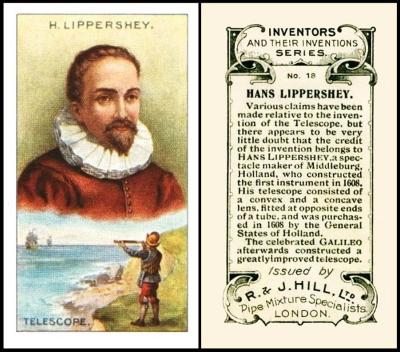
And lastly we have Hans Lippershey, the inventor of the telescope, which really is the best way to see any kind of moon.
Though here it is shown being used for what was its most usual use originally, scanning the sea (or land) for signs of invasion
This set first appears in our original reference book to the issues of R. & J. Hill, RB.2, issued in 1942. There were several versions of it, five in all, including two which were issued later, in 1934, which have been tackled elsewhere. (to be tracked down)
The text of the 1907 versions in this booklet reads :
1907. 20. INVENTORS AND THEIR INVENTIONS. (titled series). Size 2 11/16" x 1 1/2". Numbered 1-20. Fronts, printed four colour letterpress with marginal line and white margins. Backs, printed in jet black, with descriptions and inscribed "Issued by R. & J. Hill Ltd., Pipe Mixture Specialists...."
1907. 20. INVENTORS AND THEIR INVENTIONS. (titled series). Size 2 11/16" x 1 1/2". Numbered 1-20. Exactly as foregoing, but backs are printed in grey-black instead of jet black; in most cases the numerals are smaller in this printing.
20. INVENTORS AND THEIR INVENTIONS. (titled series). Size 2 11/16" x 1 1/2" approx. Numbered 21-40. (This is not inscribed 2nd Series, but the subjects are different from the above). Fronts, printed in four colour letterpress with marginal line and white margins : subjects titled. Backs, printed in olive-green, with descriptions and inscribed "Issued only by R. & J. Hill Ltd. (Proprietors of Hy. Archer & Co.)". (See Henry Archer & Co.). This set is also known to exist with plain backs.
That may be the first reference, but they appeared in the 1950 London Cigarette Card Company catalogue as :
23. C2. C. 20 Inventors & Their Inventions Series, Nd. 1-20 (1907) - H.213
A. Black back, white card ...................... odds 4/6 to 12/6, sets £12
B. Black back, toned card (shorter) .... odds 8/6 to 25/-, no sets available24. C2. C. 20 Inventors & Their Inventions Series,
Nd. 21-40 (1907) ..................................... odds 15/- to 40/-, no sets available
The abbreviations in the first three columns are their reference number, the size, C2 being slightly smaller than the standard C size, and the second C meaning that the cards are coloured.
As for the H.213, this refers to their own handbook, which was compiled by their Charles Lane Bagnall and our Edward C. Wharton Tigar, and published uniform with their catalogue in 1950. That description opens a huge can of worms and reads :
H.213. INVENTORS AND THEIR INVENTIONS SERIES - or - GREAT INVENTORS - or - INVENTORS SERIES - or - SCIENTIFIC INVENTIONS AND DISCOVERIES (mostly titled series but some untitled). Fronts in colour (except Hill`s post-1920 plain backed issues). Numbered (except Hill`s plain backed issues)
There is a basic similarity only in the various issues, a total of over 50 different subjects occurring in the combined series. Hill used the series first in 1907, and subsequent issuers substituted cards to cover new inventions, adjusting and renumbering accordingly.Pre `1919 Hill - Titled "Inventors and Their Inventions Series" (except plain backed anonymous issues)
Nd. 1-20 Black back, white card
Nd. 1-20 Black back, toned card (shorter)
Nd. 21-40 Green backPost 1920 Anonymous (Hill) - Unicoloured, untitled, unnumbered, plain back. 20 small cards
(a) black and white (b) brown fronts
Hill - Coloured, titled "Scientific Inventions and Discoveries", Nd. 1-35.
A. Small cards, "The Spinet House" back
B. Small cards, "The Spotlight Tobacco" back
C. Large cards.
Murray - Titled "Inventors" Series, Nd. 1-20
Whitford & Sons - Untitled. Nd. 1-20Overseas - Anonymous (Teofani) - Titled "Great Inventors". Back illustrated in C.C.N., Vol.14, page 80. Nd. 1-20
Bucktrout - Untitled series. Nd. 1-20. Cards are found (a) overprinted with high serial numbers - in connection with a prize scheme (b) without serial numbers. Back illustrated in C.C.N., Vol 14, page 96.Trade - Cave, Austin & Co. Ltd (tea, etc) Titled "Inventors" Series. Nd. 1-20
Sword & Co. - Untitled. Nd. 1-20
We have featured two of these versions before, as part of newsletters - the Bucktrout one in the edition dated the 2nd of March, 2024, as the diary card for Tuesday, 5th March - and the Whitford & Sons one in the edition dated 15th of July, 2023, as the diary card for Thursday, 20th July.
We also featured a strange black and white version as our Card of the Day for the 14th of August 2023, this being a set of thirty-five cards in black and white, titled "Scientific Inventions and Discoveries" - but advertising the Spotlight brand of tobacco
In our original World Tobacco Issues Index, the Hill 1907 issue is shortened, to :
INVENTORS AND THEIR INVENTIONS SERIES. Sm. See H.213 ... H46-12
1. Nos 1/20, back in black
A. Size 68 x 37, white card. B. Size 68 x 37, toned card.
2. Nos. 21/40, back in green.
This is more or less the same in the updated version, except that the second series is followed by "(20)", this being the total number in that second set
Tuesday, 12th November 2024
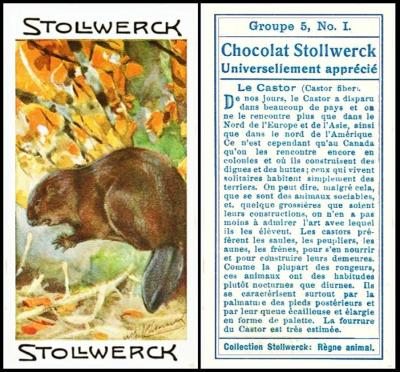
In honour of the animal whose industriousness led to the naming of this moon, here is a beaver, from about the turn of the twentieth century - yet beavers have been around for generations longer, from the time, even, before the continents were split asunder. We know this because there are beavers in America and Europe, including Asia, which come from the same root stock, but have evolved independent of each other in order to to suit their location. changing the colour and thickness of their fur, and even developing differently shaped skulls and jaws to suit the local trees, which they not only eat (along with other vegetation) but convert into their homes and surrounding landscapes, making huge networks of dams and lodges around rivers and waterways.
The Trading Card Database/beaver tells us that there are forty-four cards of beavers. The curious thing though is that whilst they list Abdul "Animals of the World" (1881) as the earliest of these cards, the same main part of the picture is used by Allen & Ginter in their "Quadrupeds" series, and that was not issued until 1890. And it does not appear to be an error of issuing date because the Abdul set actually says "Copyright 1881". I will do a bit more research on this over the coming days.
This set was issued by Stollwerck and it comes from group 5. It is also card 1. The entire set is a hundred and forty-four cards, twenty-four groups each of six cards. Our group translates as "Swimming and Diving Animals", and the cards in the set are
- Beaver
- Sealion
- Bittern
- Black Swan
- Kingfisher
- Auk
This is rather an odd group, four birds and two animals.
One of the first things you will notice is our card it calls the beaver "Le Castor" - which is a good time to mention that on European cards you will often find them called "Castor" - though this is actually their species or genus and it was given them by Carl Linnaeus in 1758.
The album titles the entire set as "Album du Regne Animal" - which I would have translated as "the album of the Animal Kingdom", but if you hunt hard enough you will discover that an album was printed for each of the Stollwerck territories, and the one for this set which was available in America and England was actually called "Animal World Album".
The other albums I have found so far are "Dierenrijk Album" (The Netherlands), "Tier Reich" (Germany), and "Samle Album Dier-rige" this being a very sought after one as it is in the Frisian language, only spoken in the Dutch province of Friesland, a few parts of Oldenburg in Germany, and along the coasts and islands of the northernmost parts of Germany.
Wednesday, 13th November 2024
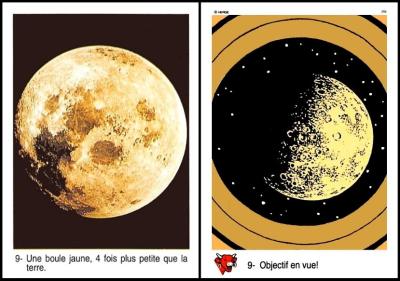
This card was chosen because the moon on it looks rather large, just as our beaver super-moon ought to - and also because it is an orange colour, which ours will be too.
Now Tintin had two encounters with the moon - starting with "Destination Moon" and moving on to "Explorers on the Moon".
The first of these was the sixteenth adventure for our boy hero and his little white dog, and it began as a serialisation in Tintin Magazine in March 1950. It was not published as a book with all the sections in until 1953. The following year saw the next adventure, which was almost a continuation, and this had started to be serialised in Tintin magazine from October 1952. This was then again collected as a complete story, and published in 1954.
Now if you are a space buff, you will realise that these adventures were very far-sighted, for the first man to step on the moon was Neil Armstrong - but not for fifteen years!
La Vache Qui Rit is most associated with small round boxes inside of which are separately wrapped triangular cheeses, the sort that we in Britain call "Dairylea" though that is quite another brand. I do not know how the cards were issued, because those boxes are round and not so large. I do know that the album for this set cost 15 francs, and the last date that you could apply for one was March 1993, so it is possible that these cards were first issued in 1992. I await to be corrected.
And, just as I started a list of the cards, I have discovered that there is a site which actually shows them all, fronts and backs, on Tintinophile.com/VQR. This proves something that I was unaware of through looking at this card - that being that one side of the card is an actual image from outer space and the other side has a Tintin related image added on.
This was not La Vache Qui Rit`s first dalliance with Tintin, because in 1972 they had issued large hexagonal stickers showing the characters, which are entitled "Tintin et ses Amis" (Tintin and his friends). I have no list of those yet - and then in 1976 they had issued a complete sheet of twelve stickers (which are today often found trimmed into smaller, single characters). The 1976 characters are -
- Tintin and Snowy
- Captain Haddock and General Tapioca
- Tintin and Snowy on a motorbike
- General Alcazar
- Colonel Esponja
- Professor Calculus's hand kiss
- Professor Calculus in the bath
- Captain Haddock is allergic to whisky?
- Tintin and the Happy Turluron
- General Tapioca
- Castafiore and her guard
- Thomson and Thompson
Thursday, 14th November 2024
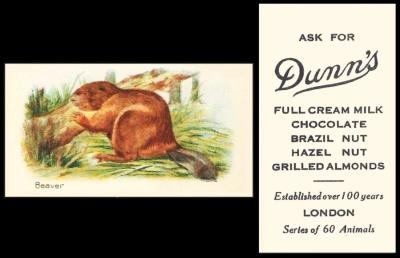
Today let us take another look at the industrious beaver, and also add a link to a set we have used before.
But first let us explore the issuer of this set, Dunn`s Chocolate. This was a real person, Daniel Dunn, and in the 1830s he became one of the first trades-persons in King`s Row, at number 9. His trade was the production of coffee essence and something called "soluble chocolate", which he claimed to have invented. This was actually cocoa powder, and was for drinking, rather than just melted chocolate.
This date does not fit with the cards, which say the firm had been "established 100 years", unless Mr. Dunn moved to Pentonville Road from other premises. That would also better explain how he "became" one of the first trades-persons in the street.
Some time in the 1850s he acquired a business partner, Mr. Charles Hewett, and about twenty years later they opened the Dunn & Hewett's cocoa factory, at Nos 136 Pentonville Road. This is thought to have been simply through outgrowing the space they had, though in the 1870s the premises was expanded still further, when the next door premises became available.
Just after the turn of the twentieth century they also opened up their staff tea rooms, at number 140, to the general public when it was not in use by those staff.
However, for some reason, despite all this industry, it closed in the 1930s.
So to our card. This appears in our original British Trade Index as :
DUNN`S, London
Chocolate. "Established 100 years". Cards issued in mid 1920s.ANIMALS. Sm. size (a) 62 x 38 (b) 67 x 35. Unnd. (60). See D/X21-359 ... DUN-1
BIRDS. Sm. 67 x 36. Unnd. (48). See D.11 ... DUN-2
The listing under D/X21-359 appears in the back of the book, actually on the final page before the list of our reference books of the time. Like most "D" numbers, this gives all the other issuers of the same cards. One of these is Hustler Soap, and we featured their version of this set as our Card of the Day for the 18th of January 2023 - where you will find lots more information about all the other versions.
However, the listing under D/X21-359 does tell us straight up that "The recording under Set 359 in RB.21 is repeated and revised below". And if you have both books, the first thing you notice there is that there is no Dunn`s set listed, only A.T.M., J. Knight, and Holloway. The reason for this is that when RB.21 was published, nobody had yet discovered that this set was also out there.
You can see both these listings in full with our Card of the Day for the 18th of January 2023 - and they make quite interesting reading. As for our set, that only appears in our British Trade Index, under D/X21-359 as
Non-Tobacco Issuers :-
(2) Dunn`s. Unnumbered. Size (a) 62 x 38 (b) 67 x 35 m/m. Set DUN-2. [NB. this is wrong, it is DUN-1]. See alphabetical list of subjects below.
That alphabetical list also appears with our Card of the Day for the 18th of January 2023.
Friday, 15th November 2024
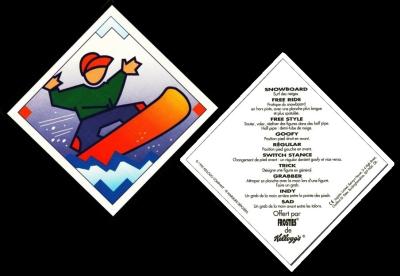
So why do we have a snowboard?
Well actually there are two reasons, but let us start with the alternative names for this moon, which are the Mourning Moon, the Darkest Depths Moon, the Blood Moon, the Frost Moon and the Freezing Moon. And it is the last two of these which suggested our card, freezing being associated with snow - but more than that, this card was issued with Kellogg`s "Frosties".
Now this is quite an unusual card, not just because it is actually a sticker. I know few cartophilic items which are this diagonal shape though, and even less which are also diagonal on the reverse - but wait, because there is another set very similar to this, and that has the front picture and the back wording straight, not running diagonally across from corner to corner. That was issued in 1995, and also in France, though the credit gives an address in Chalfont St. Peter. Even more odd, there is a snowboard as one of those stickers too, but it is much more stylised than our card. Anyway I will see if I can track someone down who can share the front and back with us.
And there we must close our presses for this week.
Missing are some of the words from our reference books which will be added over the weekend, but I can stand up and admit that I did jolly well to get this finished, definitely enough to earn myself a coffee. Some of my efforts were inspired by the fact that I did pick some very interesting subjects which I much enjoyed researching, and some by the soundtrack on another window hidden behind the scenes - which tonight has been courtesy of another of my favourites, U2.
Thanks for coming over, hope you enjoyed it, and most of all that you have been inspired enough to go off and research some of the things I did not get around to. And if you did enjoy it, tell your friends and fellow collectors.
And I look forward to seeing you all again next week
